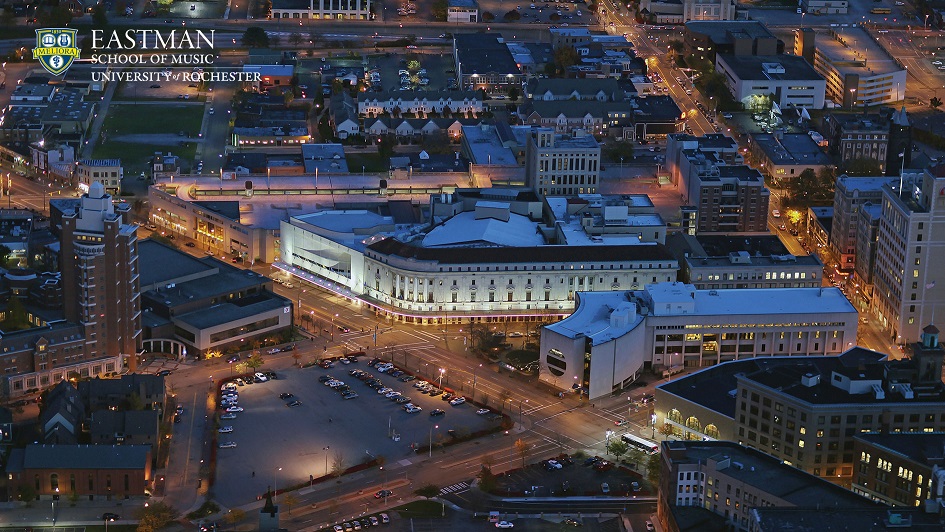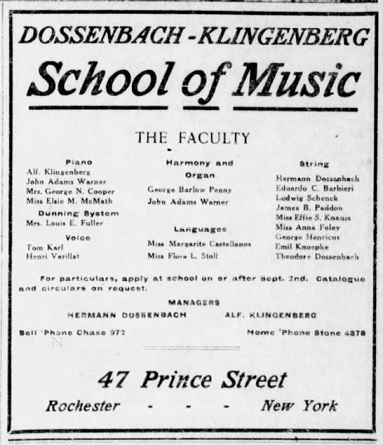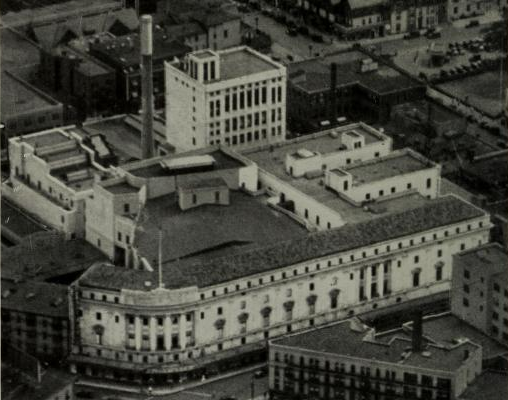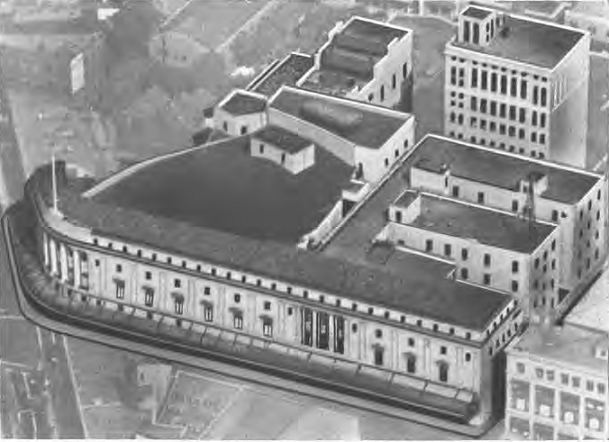
| Eastman School of Music |
 |
| Aerial view of Eastman
School of Music |
 |
 |
 |
| Democrat
and Chronicle, August 30, 1913, Page 15. |
Aerial View of Eastman School circa
1927, from The
Eastman School of Music: Its First Quarter Century, 1921-1946, by Charles Riker |
Aerial View of Eastman School, from The University of Rochester: A Story of Expansion and its Background, by Hugh A. Smith (1930) |
The Rochester Conservatory of Music was incorporated in December, 1907 and the following year bought out John D. Beall's Rochester School of Music. In 1910 the Conservatory bought a building at 81 South Fitzhugh Street.
Musicians Alf Klingenberg and Hermann Dossenbach established the Dossenbach-Klingenberg School of Music in the fall of 1913 and it was provisionally chartered by the Regents of the University of the State of New York on September 25, 1913. Klingenberg and Dossenbach chose a building at 47 Prince Street for their school, which they purchased from William Gleason of the Gleason Works. Facilities for the new school were enhanced through the construction of a building at the rear of the property to provide for a recital hall and auditorium.
Klingenberg' s choice of location was as astute as his choice of partner, since the new school was situated adjacent to the campus of the University of Rochester and diagonally across the street from Sibley Hall, which housed the Sibley Music Library. This collection, given to the University in 1904 by Hiram W. Sibley, was an invaluable resource, and its nearby location was of obvious advantage to the new school.
The school was reorganized in 1914 with Oscar Gareissen and renamed the D.K.G. Institute of Musical Art. In 1916 the institute was consolidated with the the Rochester Conservatory of Music to form the D.K.G. Institute of Musical Art and Rochester Conservatory of Music, although the second name soon faded from view. On July 19, 1918, George Eastman purchased the school for $28,000, including its property and corporate rights and for the next 315 days Eastman was the sole owner of the school. The University's charter was amended by the State Board of Regents on December 12, 1918, allowing the granting of music and other professional degrees. Several parcels on Gibbs, Main and Swan Streets were sold to the University in early 1919 and on June 12, 1919 George Eastman transferred Institute of Music and its property on Prince Street for $1.00. Ground was broken for the new school in early 1920..
Eastman, who founded the photo giant Eastman Kodak Company and the music school that bears his name, wanted the School and the Eastman Theatre to span Main Street from Gibbs to Swan Streets. When the owner of the property at Main and Swan, Alexander B. Lamberton, demanded too high a price, Eastman refused and built around the property. The University finally acquired this parcel in 1961 and used it as a parking lot for many years until the East Wing was built.
Buildings | Eastman
School of Music Map (January 17, 2019) |
1913 Dossenbach-Klingenberg School of Music
1919 "Eastman School of Music Added to University," Democrat and Chronicle, June 18, 1919, Page 18.
1922 Eastman Theatre
1924 Eastman Annex 1
1925 Eastman Dormitories (on Prince Street Campus)
1927 Eastman Annex 2
1937 Sibley Music Library
1951 Hutchison House
1955 | Cutler Union | Munro Hall |
1975 Eisenhart Home
1988 Miller Center (formerly Eastman Place)
1991 Eastman Commons Student Living Center
2005 Messinger Hall
2010 East Wing
2023 East End Garage
References
| also see History of
Music in Rochester |
1916 "Rochester
Schools Form Combination," Musical America 24:20 (July 1,
1916)
Amalgamation of the Rochester Conservatory of Music and the D.K.G.
Institute of Musical Art.
1916 "Rochester Solving Problems of Music for the Multitude," Musical America 24:139 (October 14, 1916)
1918 "New
Plan for Institute of Music," Democrat and Chronicle, May 6,
1918, Page 17.
Provided contributions of not less than $2,500 a year for five years are
obtained, George Eastman has offered to purchase the property now housing
the Institute of Musical Art, No. 47 Prince street, the institution to be
chartered by the regents of the University of the State of New York. Mr.
Eastman would present the property to the trustees of the new corporation,
in which no trustee or other individual would hold stock or have any
proprietary interest. The contributions asked by Mr. East- 47 Prince
Street. man would supplement for the support of an educational musical
institution the income from pupils. Another provision stipulates that Alf
Klingenberg, the present director, remain as director and teacher of piano
for not less than five years. Through co-operation with the
University of Rochester, it is said, the usual lour-year course would be
enlarged by the addition of college subjects.
1919 "Concert Hall and School of Music in Building to be put up by George Eastman," Democrat and Chronicle, February 14, 1919, page 21.
1919 Deed
from William H. Ward to the University of Rochester, February 27,
1919, book 1052, page 162.
Lot on Swan Street.
1919 Deed
from Leonard B. Bacon to the University of Rochester, April 5, 1919,
book 1054, page 365.
Lot at corner of Main and Gibbs Streets.
1919 "Music Hall Site Will Take in Lot This House Occupies," Democrat and Chronicle, April 9, 1919, page 21.
1919 "Million
Building Fund for Eastman School of Music; Endowment Fund $2,139,000,"
Democrat and Chronicle, August 6, 1919, Page 21.
These and other details made public by Dr. Rush Rhees at dinner of
National Association of Motion Picture Industry.
1920 "Eastman School of Music to Develop Rochester into Community of Music Lovers," Democrat and Chronicle, February 20, 1920, page 21.
1922 "Central Heating Plant," The Note Book, March 2, 1922, Page 3.
1922 "The following-named firms and individuals participated in the construction and equipment of the new Eastman Theater and School of Music," Democrat and Chronicle, September 10, 1922, Page 8.
1923 "Eastman Theatre and School of Music," American Architect and Architecture 123(2424):181-200 (February 28, 1923)
1923 "The Heating and Ventilating System and Soundproofing for the Eastman Theatre and School of Music," by Allen S. Crocker American Architect and Architecture 123(2424):200-202 (February 28, 1923)
1923 "New Story to be Added to Eastman Theater Wing to Provide Ballet Studio," Democrat and Chronicle, June 24, 1923, Page 33.
1923 "New
Electric Station Will Supply Theater," Democrat and Chronicle,
June 28, 1923, Page 19.
New Substation to convert alternating current to direct current to be
distributed to customers in that section.
1923 "The Electrical and Illuminating Equipment of the Eastman Theatre and School of Music," by Frederick A. Mott and Loyd A. Jones, Journal of the American Institute of Electrical Engineers 42(6):569-582 (June 1923)
1923 "Huge
Generator for Swan Street Station Arrives," Democrat and
Chronicle, October 18, 1923, Page 21.
3,000-horsepower motor generator set.
1923 A Monograph of the Work of Gordon & Kaelber Architects
1926 "Test Music School Boiler," Campus, February 19, 1926, Page 8.
1926 Plat
Book of the City of Rochester
Plate
2: Eastman School and Theatre
Plate
8: Eastman School Annex and Powerhouse
1927 "Eastman
Theater Issues Booklet," Democrat and Chronicle, March 1,
1927, Page 24.
Building and Music School Pictures and Described.
1927 Rochester,
the making of a university, by Jesse Leonard Rosenberger, with
an introduction by President Rush Rhees.
Page 302-316: Eastman School of Music
1928 Rochester
Gas & Electric News & Year Book, February, 1928
Pages
18-21: Progress in the Steam Department
During 1927.Au additional load of 275,000,000 pounds of steam was
contracted for which means an increase of approximately $230,000 in annual
revenue.
In addition to the customers obtained in the Broad Street Section, a
number of large consumers were obtained in the Lawn Street District.
Among these are the Eastman Theatre and School of Music
1928 "Eastman
School Annex Set Fire by Cigarette," Democrat and Chronicle,
May 18, 1927, Page 21.
Two-story frame structure at 28 Swan street.
1929 "A Retrospect of Music in Rochester," by Stewart Sabin, Rochester Historical Society 11:45-90 (1929)
1931 The Eastman School of Music, 1921-1931, a decade of progress, by Howard Hanson
1933 "Janitor
at Eastman Falls Dead at Work," Democrat and Chronicle,
March 4, 1933, Page 12.
Louis Thorns.
1935 Plat
Book of the City of Rochester
Plate
1: Eastman School and Theatre
1940 Milestones in the history of music. A series of programs illustrating the development of musical composition presented over station WHAM and the Red network of the National Broadcasting Company, 1940-1941, by Eastman School of Music.
1948 The Eastman School of Music: Its First Quarter Century, 1921-1946, by Charles Riker
1955 "University to Use Prince St. Campus for Eastman School," Democrat and Chronicle, February 7, 1955, Page 13.
1961 "Main-Swan
Site Sold to UR for $225,000," Democrat and Chronicle, July
7, 1961, Page 16.
Sold by Jarold Properties, Inc. The university took over a $60,250
mortgage and paid the remainder in cash.
1963 "The Expanding University: 5.-The Eastman School of Music," Democrat and Chronicle, August 11, 1963, Page 1M. | Part 2 |
1963 The Eastman School of Music, 1947-1962: A Sequel, by Charles Riker
1974 "City
Asks UR to Delay Decision," Campus Times, January 21, 1974,
Page 1. | Part
2 |
Opposes ESM Move
1974 "Director Freeman Weighs Possible Eastman Move," Campus Times, March 1, 1974, Page 1 | Part 2 |
1975 "Changing
times at Eastman School," Democrat and Chronicle, February
16, 1975, Page 1E. | Part
2 |
This is the first of a four part series
1975 "The question: Should it be moved?" Democrat and Chronicle, February 17, 1975, Page 1C. | Part 2 |
1975 "Robert Freeman and Eastman's Future," Democrat and Chronicle, February 18, 1975, Page 1C. | Part 2 |
1975 "A Conversation with Robert Freeman," Democrat and Chronicle, February 19, 1975, Page 1C.| Part 2 |
1975 "Eisenhart
home given to school," Democrat and Chronicle, August 10,
1975, Page 2B. | part 2 |
The 1316 East Avenue home of the late Mr. and Mrs. M. Herbert Eisenhart
will be given to the University of Rochester and used by its Eastman
School of Music as a residence and meeting place. Mr. Eisenhart, who died
this year, stipulated in his will that the residence, together with the
income from a $250,000 fund for its maintenance and upkeep, was to be used
as the family determined. The house, located at the northwest corner of
East Avenue and East Boulevard will be used initially as a residence for
the director of the University's Eastman School of Music.
1975 The Eastman School of Music and the Eastman Theatre, by Lois K. Clutz
1977 "$5 million facelift at Eastman School," University Record 17(2):3 (February 1977)
1977 History
of the University of Rochester, 1850-1962, by Arthur J.
May. Expanded edition with notes
Chapter 18, The Birth of a Music Center
On Monday, September 12, 1921, the Eastman School of Music opened its
doors to students, one hundred and four of them "regulars" of whom
fifty-nine were candidates for certificates and forty-five were aspirants
for a bachelor's degree; women outnumbered men in a ratio of seven to one.
Over 1,200 entered as special students or in the preparatory department.
While the stage was large, it was less spacious than had been envisaged in
the preliminary planning; off from it were sixteen dressing rooms for
performing artists and facilities for one hundred orchestra players. Until
1926 warmth for the entire music center was supplied by a plant on the
east side of Swan Street; thereafter, heat was purchased from the
Rochester Gas and Electric Company.
Since the facilities for teaching soon proved inadequate, two annexes were
erected along Swan Street. The first, of five stories, adjacent to the
Theatre and available in 1924, furnished space principally for orchestral
rehearsals, ballet training, and the preparation of properties for
operatic spectacles; a runway crossed over to the stage entrance of the
Theatre. Executives of the School and Theatre were assigned garage space
on the ground level; Eastman, Rhees, and Todd on concert nights parked
their cars in the heating plant.
Ten days before he took his life, Eastman wrote, "I am returning the
key... as it is not likely that I will want to use the Swan Street garage
any more...."
The second annex, a ten-story structure built in 1926 and linked to the
School by a covered bridge, greatly enlarged the number of classrooms,
studio and practice rooms, and contained a special area for the opera
department, a gymnasium, and a laundry. For a few years, the former home
of the Institute of Musical Art on Prince Street was used as a dormitory
for women students, but in 1925, as is related later, residence halls for
women along University Avenue were completed and the old Institute
building thereafter served as living quarters for a few men students.
In the meantime, praiseworthy progress had been made in equipping the
school with one of the largest, finest, most comprehensive musical
libraries in the United States. Collections of books on music and musical
manuscripts acquired by Hiram W. Sibley of Rochester formed the solid
nucleus of the library. A lover of music himself, Sibley in 1904 had been
persuaded to collect musical works by Elbert Newton, organist of the
Central Presbyterian Church, who acted as purchasing agent. In the
capacity of "angel," Sibley wished a "working" collection of books without
"frills and curiosities," and in the light of that, directive Newton
concentrated on buying standard titles and a considerable quantity of
"modern" music. The holdings were deposited in the Sibley Library, built
by the donor's father, on the Prince Street Campus; Sibley paid the salary
of a curator who issued a catalogue of the collection and supplements.
Although any responsible Rochesterian might borrow books, circulation was
not large, but used freely by students in the nearby Institute of Musical
Art.
In January of 1922 the Sibley collection was transferred to the music
center and installed in a large room at the southeast corner of the first
floor corridor of the School. Known as the Sibley Musical Library, the
growing collections remained there until the separate library building
became available (1937). On a wall of the reading room a portrait of the
benefactor was hung (along the corridor a likeness of Wolfgang A. Mozart
looked down benignly on the passing scene), and a bronze tablet just
inside the entrance read: "This Musical Library given by Hiram W. Sibley
is for the use of all music lovers in Rochester."
Chapter 28, Music and Medicine in the 1930's
Expansion of book collections and increase in the student body caused
insufferable congestion in the temporary library quarters. Consequently,
in 1937, a music library building, believed to be the first of its kind in
America, was erected on the east side of Swan Street, and the former
library facility was refitted as a relaxation lounge for students and
teachers. On February 10, 1938, the new structure was formally dedicated.
The book circulation department, card catalogues, and space for reading
occupied the first level, while on the second floor seminar and listening
rooms were provided. According to the original blueprints, book stacks
would rise to ten levels with cubicles for study along the eastern wall;
however, only four stacks were in fact built and plans for an elevator,
alas, were not carried out.
1981 Potential
Opportunities for Revitalization of the Rochester, New York Steam
District Heating System, by Robert E. Gant, Michael A.
Karnitz, Carroll W. Easton and Carl H. Thiele, September 1981.
Page B-6: Steam customers converted to other fuels: U of R
Eastman School of Music 3/79 21,205 Annual Mlbs of steam.
1983 "UR,
Eastman may build downtown," Democrat and Chronicle, January
25, 1983, Page 1A. | Part
2 |
Schools considering office building next to Eastman Theater.
1987 "A History of the Eastman Theatre," by Vincent A. Lenti, Rochester History 49(1):1-24 (January 1987)
1996 "The Eastman School of Music," by Vincent A. Lenti, Rochester History 58(4):1-32 with illus (Fall 1996)
1996 George Eastman: A Biography, by Elizabeth Brayer | another copy |
2004 For the Enrichment of Community Life: George Eastman and the Founding of the Eastman School of Music. by Vincent Lenti
2009 Serving a Great and Noble Art: Howard Hanson and the Eastman School of Music, by Vincent A. Lenti
2013 Hermann Dossenbach: Founding Father of Orchestral Music in Rochester, by Juliet Wu
2022 "Rediscovering
the genius of R. Nathaniel Dett," by Mona Seghatoleslami, Rochester
City Newspaper, February 2022
First black graduate of the Eastman School of Music
© 2021 Morris A. Pierce